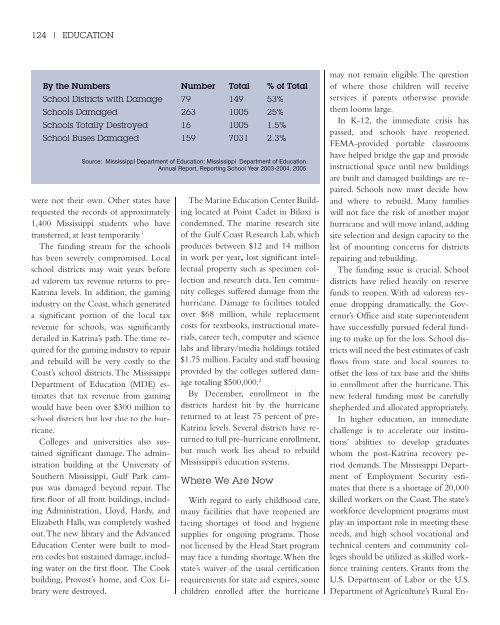Reports - Mississippi Renewal
Reports - Mississippi Renewal
Reports - Mississippi Renewal
- No tags were found...
You also want an ePaper? Increase the reach of your titles
YUMPU automatically turns print PDFs into web optimized ePapers that Google loves.
124 | EDUCATIONBy the Numbers Number Total % of TotalSchool Districts with Damage 79 149 53%Schools Damaged 263 1005 25%Schools Totally Destroyed 16 1005 1.5%School Buses Damaged 159 7031 2.3%Source: <strong>Mississippi</strong> Department of Education; <strong>Mississippi</strong> Department of Education.Annual Report, Reporting School Year 2003-2004. 2005.were not their own. Other states haverequested the records of approximately1,400 <strong>Mississippi</strong> students who havetransferred, at least temporarily. 1The funding stream for the schoolshas been severely compromised. Localschool districts may wait years beforead valorem tax revenue returns to pre-Katrina levels. In addition, the gamingindustry on the Coast, which generateda significant portion of the local taxrevenue for schools, was significantlyderailed in Katrina’s path. The time requiredfor the gaming industry to repairand rebuild will be very costly to theCoast’s school districts. The <strong>Mississippi</strong>Department of Education (MDE) estimatesthat tax revenue from gamingwould have been over $300 million toschool districts but lost due to the hurricane.Colleges and universities also sustainedsignificant damage. The administrationbuilding at the University ofSouthern <strong>Mississippi</strong>, Gulf Park campuswas damaged beyond repair. Thefirst floor of all front buildings, includingAdministration, Lloyd, Hardy, andElizabeth Halls, was completely washedout. The new library and the AdvancedEducation Center were built to moderncodes but sustained damage, includingwater on the first floor. The Cookbuilding, Provost’s home, and Cox Librarywere destroyed.The Marine Education Center Buildinglocated at Point Cadet in Biloxi iscondemned. The marine research siteof the Gulf Coast Research Lab, whichproduces between $12 and 14 millionin work per year, lost significant intellectualproperty such as specimen collectionand research data. Ten communitycolleges suffered damage from thehurricane. Damage to facilities totaledover $68 million, while replacementcosts for textbooks, instructional materials,career tech, computer and sciencelabs and library/media holdings totaled$1.75 million. Faculty and staff housingprovided by the colleges suffered damagetotaling $500,000. 2By December, enrollment in thedistricts hardest hit by the hurricanereturned to at least 75 percent of pre-Katrina levels. Several districts have returnedto full pre-hurricane enrollment,but much work lies ahead to rebuild<strong>Mississippi</strong>’s education systems.Where We Are NowWith regard to early childhood care,many facilities that have reopened arefacing shortages of food and hygienesupplies for ongoing programs. Thosenot licensed by the Head Start programmay face a funding shortage. When thestate’s waiver of the usual certificationrequirements for state aid expires, somechildren enrolled after the hurricanemay not remain eligible. The questionof where those children will receiveservices if parents otherwise providethem looms large.In K-12, the immediate crisis haspassed, and schools have reopened.FEMA-provided portable classroomshave helped bridge the gap and provideinstructional space until new buildingsare built and damaged buildings are repaired.Schools now must decide howand where to rebuild. Many familieswill not face the risk of another majorhurricane and will move inland, addingsite selection and design capacity to thelist of mounting concerns for districtsrepairing and rebuilding.The funding issue is crucial. Schooldistricts have relied heavily on reservefunds to reopen. With ad valorem revenuedropping dramatically, the Governor’sOffice and state superintendenthave successfully pursued federal fundingto make up for the loss. School districtswill need the best estimates of cashflows from state and local sources tooffset the loss of tax base and the shiftsin enrollment after the hurricane. Thisnew federal funding must be carefullyshepherded and allocated appropriately.In higher education, an immediatechallenge is to accelerate our institutions’abilities to develop graduateswhom the post-Katrina recovery perioddemands. The <strong>Mississippi</strong> Departmentof Employment Security estimatesthat there is a shortage of 20,000skilled workers on the Coast. The state’sworkforce development programs mustplay an important role in meeting theseneeds, and high school vocational andtechnical centers and community collegesshould be utilized as skilled workforcetraining centers. Grants from theU.S. Department of Labor or the U.S.Department of Agriculture’s Rural En-




